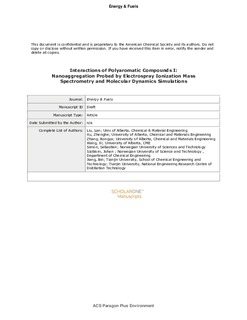| dc.contributor.author | Liu, Lan | |
| dc.contributor.author | Zhang, Rongya | |
| dc.contributor.author | Wang, Xi | |
| dc.contributor.author | Simon, Sebastien Charles | |
| dc.contributor.author | Sjøblom, Johan | |
| dc.contributor.author | Xu, Zhenghe | |
| dc.contributor.author | Jiang, Bin | |
| dc.date.accessioned | 2018-02-27T13:57:43Z | |
| dc.date.available | 2018-02-27T13:57:43Z | |
| dc.date.created | 2017-12-13T09:13:07Z | |
| dc.date.issued | 2017 | |
| dc.identifier.citation | Energy & Fuels. 2017, 31 (4), 3465-3474. | nb_NO |
| dc.identifier.issn | 0887-0624 | |
| dc.identifier.uri | http://hdl.handle.net/11250/2487454 | |
| dc.description.abstract | Nanoaggregation of three synthetic polyaromatic compounds, N-(1-hexylhepyl)-N′-(5-carboxylicpentyl)-perylene-3,4,9,10-tetracarboxylicbisimide (C5Pe), N-(1-undecyldodecyl)-N′-(5-carboxylicpentyl)-perylene-3,4,9,10-tetracarboxylbisimide (C5PeC11), and N,N′-bis(1-undecyldodecyl)perylene-3,4,9,10-tetracarboxylbisimide (BisAC11), individually or in their binary mixtures was studied under various solution conditions using electrospray ionization mass spectrometry (ESI–MS) and molecular dynamics (MD) simulation. The results from ESI–MS showed a significant enhancement in nanoaggregation of each individual component by increasing their concentration or heptane addition to toluene. Mixing a polyaromatic compound of longer aliphatic chain with a shorter chain polyaromatic compound in a given solvent was found to significantly reduce the apparent average nanoaggregation number. Replacing the −COOH group with an aliphatic group induced further steric hindrance to nanoaggregation of polyaromatic cores in the mixture. The results from MD simulations showed a similar trend of reducing nanoaggregation by mixing of two different polyaromatic compounds. The results of MD simulation further revealed that π–π stacking between polyaromatic cores is the major driving force for nanoaggregation, while steric repulsion and strong solvation of longer aliphatic chains connected to the polyaromatic core hinder nanoaggregation of polyaromatic compounds studied. The results from this study provide a scientific basis for controlling nanoaggregation of polyaromatic compounds and shed light on understanding the observed aggregation of asphaltenes in crude oil. | nb_NO |
| dc.language.iso | eng | nb_NO |
| dc.publisher | American Chemical Society | nb_NO |
| dc.relation.uri | http://pubs.acs.org/doi/10.1021/acs.energyfuels.6b03029 | |
| dc.title | Interactions of Polyaromatic Compounds. Part 1: Nanoaggregation Probed by Electrospray Ionization Mass Spectrometry and Molecular Dynamics Simulation | nb_NO |
| dc.type | Journal article | nb_NO |
| dc.type | Peer reviewed | nb_NO |
| dc.description.version | acceptedVersion | nb_NO |
| dc.source.pagenumber | 3465-3474 | nb_NO |
| dc.source.volume | 31 | nb_NO |
| dc.source.journal | Energy & Fuels | nb_NO |
| dc.source.issue | 4 | nb_NO |
| dc.identifier.doi | 10.1021/acs.energyfuels.6b03029 | |
| dc.identifier.cristin | 1526560 | |
| dc.relation.project | Norges forskningsråd: 234112 | nb_NO |
| dc.description.localcode | © 2017. This is the authors' accepted and refereed manuscript to the article. Locked until 8.2.2018 due to copyright restrictions. The final authenticated version is available online at: https://pubs.acs.org/doi/10.1021/acs.energyfuels.6b03029 | nb_NO |
| cristin.unitcode | 194,66,30,0 | |
| cristin.unitname | Institutt for kjemisk prosessteknologi | |
| cristin.ispublished | true | |
| cristin.fulltext | original | |
| cristin.fulltext | preprint | |
| cristin.qualitycode | 2 | |
